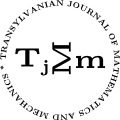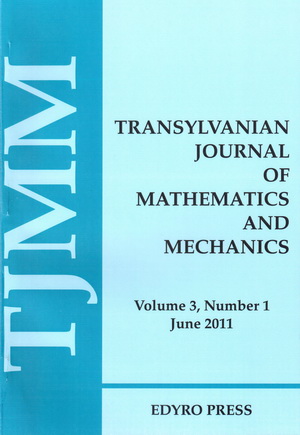Volume 4 (2012), Number 1
DUAL and BIPOLAR Mathematical Models Derived from the Solutions of Two Very Simple Mathematical Equations and Their Application in Physics
Author(s): MALVINA BAICA AND MIRCEA CARDU
Abstract: In this paper we develop a “Dual” model for the use in for solving wave and corpuscle problems in Quantum Mechanics relative to behavior of light in some diverse processes in Physics. For example, in the course of emissions and absorption in the Photo Electric Effect and in the Compton Light Effect there are observations of a corpuscular nature. Conversely, while observing the phenomena of interference, diffraction, interference and polarization, light exhibits an oscillatory character. The dual model will, applied to these phenomena, be able to distinguish among these separate effects. We further perform a “Bipolar” model for problems common to electric fields and the magnetic fields (these fields must occur simultaneously). Each propagation direction of the electromagnetic wave can be represented by two sinusoid curves situated in two perpendicular planes. One of them represents the oscillations of the electrical intensity vector and the other represents the oscillations of magnetic intensity vector. These can be accorded a unified treatment by the proposed new bipolar model. There are many such phenomena in Physics which exhibit either a dual behavior or a bipolar behavior. The work is to be based upon algebra, mathematical logic, quantum theory and electromagnetic theory. Both models will emerge from the solutions of similar but not identical equations.
DownloadAn Application of Univalent Solutions to Fractional Volterra Equation in Complex Plane
Author(s): AISHA AHMED AMER AND MASLINA DARUS
Abstract: In this article, we discuss the existence and uniqueness of solution to fractional Volterra equation in complex plane. We apply our results on the single species model of Volterra type. Fixed point theorems are the main tool used here to establish the existence and uniqueness results. First we use Banach contraction principle and then Krasnoselskii‘s fixed point theorem under certain conditions. Moreover, we prove that the solution can be extended to maximal interval of existence.
DownloadConvergence of a Generalized Iterations for a Countable Family of Nonexpansive Mappings
Author(s): MOHSEN ALIMOHAMMADY AND VAHID DADASHI
Abstract: In this paper we propose a new modified Mann iterations with certain control conditions for a countable family of nonexpansive mappings in Banach spaces. The sequence generated by the iteration converges strongly to a common fixed point in which is a solution of certain variational inequality. Moreover, we get a specific conclusion from main results.
DownloadPolynomial Coefficients and Approximation Errors of Entire Series
Author(s): HUZOOR H. KHAN AND RIFAQAT ALI
Abstract: In this paper we consider the maximum of entire function over a certain lemniscate instead of considering the maximum of on and obtained analogous results for entire functions of the form , where is a polynomial of degree and is of degree . The -order and generalized -type have been characterized in terms of Polynomial Coefficients and approximation errors, . Finally, a saturation theorem for which can be extended to a entire function of -order 0 or 1 and for entire functions of minimal generalized -type have been obtained.
DownloadOn Polynomial Instability of Variational Difference Equations in Banach Spaces
Author(s): MIHAELA AURELIA TOMESCU
Abstract: The object of this paper is to study two concepts of polynomial instability for variational nonautonomous difference equations in Banach spaces. Obtained characterizations for these concepts are generalizations of the classical results due to E.Barbashin ([1]), R.Datko ([4]) and A. Lyapunov ([6]) for variational difference equations.
DownloadOn Optimizing Linear Multiple Regression Models Using Stepwise Regression
Author(s): CONSTANTIN ZĂVOIANU AND FELICIA ZĂVOIANU
Abstract: This article is focused on the problem of optimizing linear multiple regression models using the stepwise regression method. Thus, the technique for constructing the computation matrix is initially presented, then, the optimization algorithm is described, and finally, the method for determining the elements that are not contained in the optimal regression model is presented. The last part of this paper contains a case study where the optimization algorithm is applied on a dataset containing authentic territorial statistical data.
DownloadGreen’s Tensor for an Elastic Circle and Its Application in Micromechanics of Defects in Solids
Author(s): SEREMET VICTOR
Abstract: The Green’s tensor for the first (displacement given) boundary value problem of elasticity for a circular domain is computed under a closed form expression. The method of solution uses the “incompressible influence element” for which the Green’s tensor is given by representation using Green’s function for Poisson’s equation. Using such a representation, is shown that the main problem is to find the dilatation along the boundary induced by the displacements Green’s function. The volume dilatation is than obtained by solving an integral equation along the circular boundary. Explicit expressions are obtained for the Green’s displacements tensor and for the traction along the circular boundary, allowing expressing the solution for any kind of “displacement” boundary condition and body forces. On the basis of the constructed Green’s tensor is given the integral formula which presents a generalization of the well known Poisson’s integral formula from the theory of harmonic potentials onto the theory of elasticity. An example of application of Green’s tensor in micromechanics of defects in solids as radial Volterra’s slip dislocation in an elastic circle is presented. These results were obtained in explicit form and for the first time. Applied here the “incompressible influence element method” (IIEM) can be used to derive the Green’s tensor for a wide classis of different boundary value problems for canonical domains of many systems of coordinates. So, IIEM will increase considerable the possibilities to solve new complicate boundary value problems in bounded and “unbounded” solids, acted by different inner actions: body forces, temperature dislocations, Volterra’s dislocations, eigenstrains, inclusions etc and any boundary displacements.
DownloadThermoelastostatic Equilibrium of Some Spherical Semi-wedges: Green’s Functions and Integral Formulas
Author(s): SEREMET VICTOR
Abstract: In this study new exact Green’s functions and new exact Green-type integral formula for a boundary value problem (BVP) in thermoelasticity for some spherical semi-wedges with mixed homogeneous mechanical boundary conditions (zero normal stresses and tangential displacements on quarter-plane and on the marginal circular infinite sector ; zero normal displacements and tangential stresses on quarter-plane ) are derived. The thermoelastic displacements are subjected to a heat source applied in the inner points of the spherical semi-wedges and to a mixed non-homogeneous boundary heat conditions (temperatures on quarter-plane and on the marginal circular infinite sector ; heat flux on quarter-plane ). When thermoelastic Green’s functions are derived, the thermoelastic displacements are created by an inner unit point heat source, described by -Dirac’s function. All results are obtained in terms of elementary functions that are formulated in a special theorem.
DownloadRegarding the Stability of Rotors Running in Variable Stiffness Bearings
Author(s): CRISTIAN PAVEL, AMELITTA LEGENDI AND RADU PANAITESCU-LIESS
Abstract: Low bearings stiffness gives rise to the rotor steady state response, this state being superior to that obtained with moderate and high bearing stiffness. The paper describes a combined theoretical- experimental investigation into the stability of a flexible rotor running in flexible bearings, with particular references to low stiffness bearings. Results show that the bearings type proposed can be used effectively without resulting in system instability.
Download

